Advancing CERN’s Frontiers: The Role of Irradiation Facilities in Experimentation and R&D
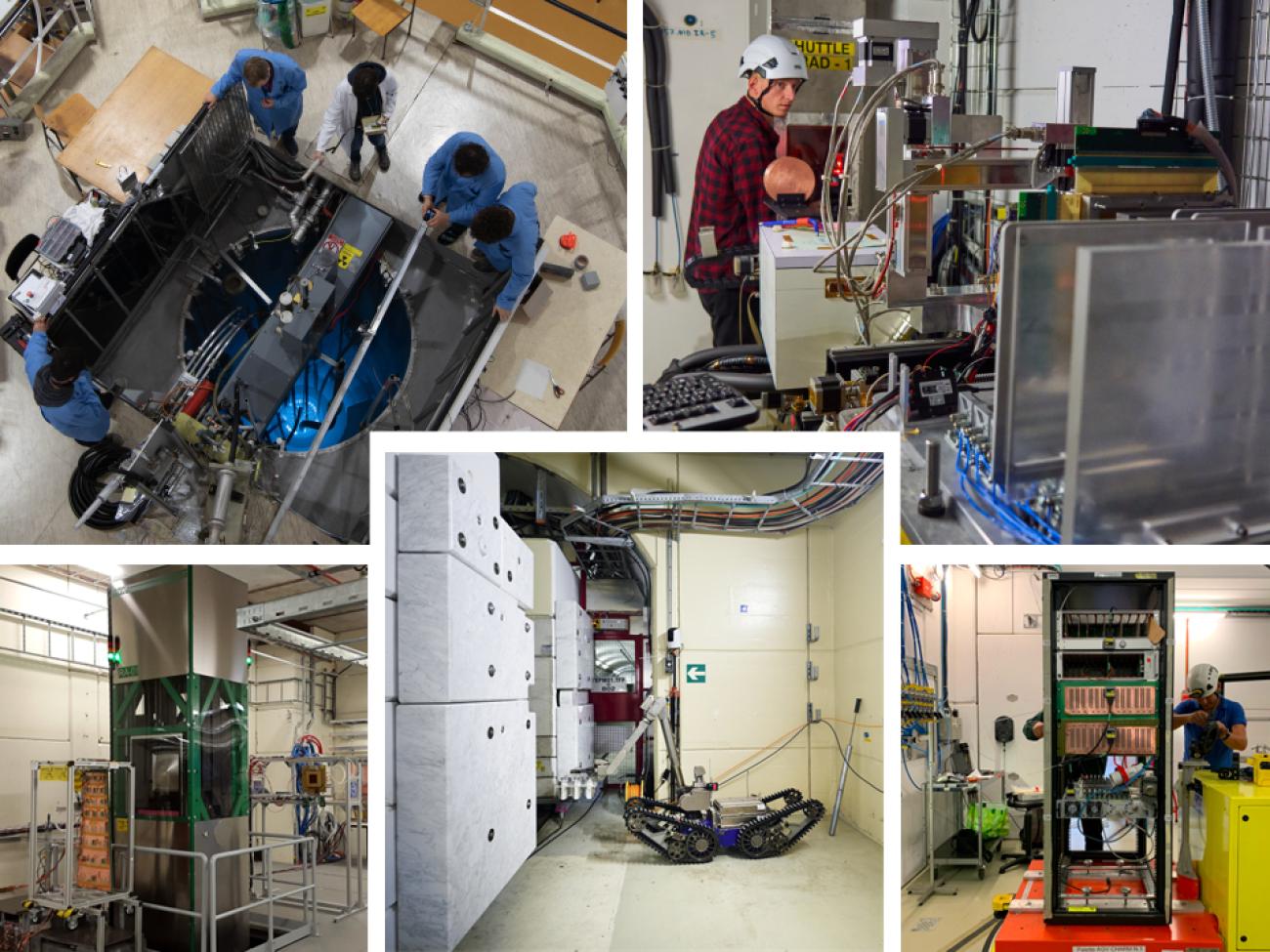
Irradiation is the process by which a material sample is exposed to radiation. This broad term encompasses various activities, from systematic qualification of components and materials following international standards to experimental research on particle detector and accelerator technologies aiming to develop devices and systems for operation in harsh radiation environments. The need of calibrating sensors, instrumentation and dosimetric techniques or benchmarking the Monte Carlo simulation also belong, for instance, to this set of activities. Irradiation Facilities thus play a fundamental role both in ensuring the long-term reliability of CERN’s accelerator complex and High Energy Physics (HEP) experiments and in supporting current and future research in accelerator and detector technologies.
The use of Irradiation Facilities for radiation-effect studies at CERN began in the early 60’s for assessing corrosion effects and the change in mechanical and electrical properties of polymeric, epoxy and semiconductor materials (Fig. 1(A)). In the early 70’s, systematic studies about insulating materials were launched within the CERN Safey Commission for the construction of the Intersecting Storage Rings (ISR) first, and the Super Proton Synchrotron (SPS) later. These studies became very systematic during the following decade (80’s), in combination with new requirements for using halogen-free, fire-resistant, low-smoke materials for the construction of the Large Electron-Positron (LEP) collider. Over three decades, these investigations relied on access to an endful of external Irradiation Facilities (for gamma-ray and neutron irradiation) and in methodical High-Level Dosimetry (HLD) measurements around CERN accelerators to follow-up the components ageing, leading to the publication of several Yellow Reports (1968-1998) which are still today one of the most prominent data collections in the field [1].
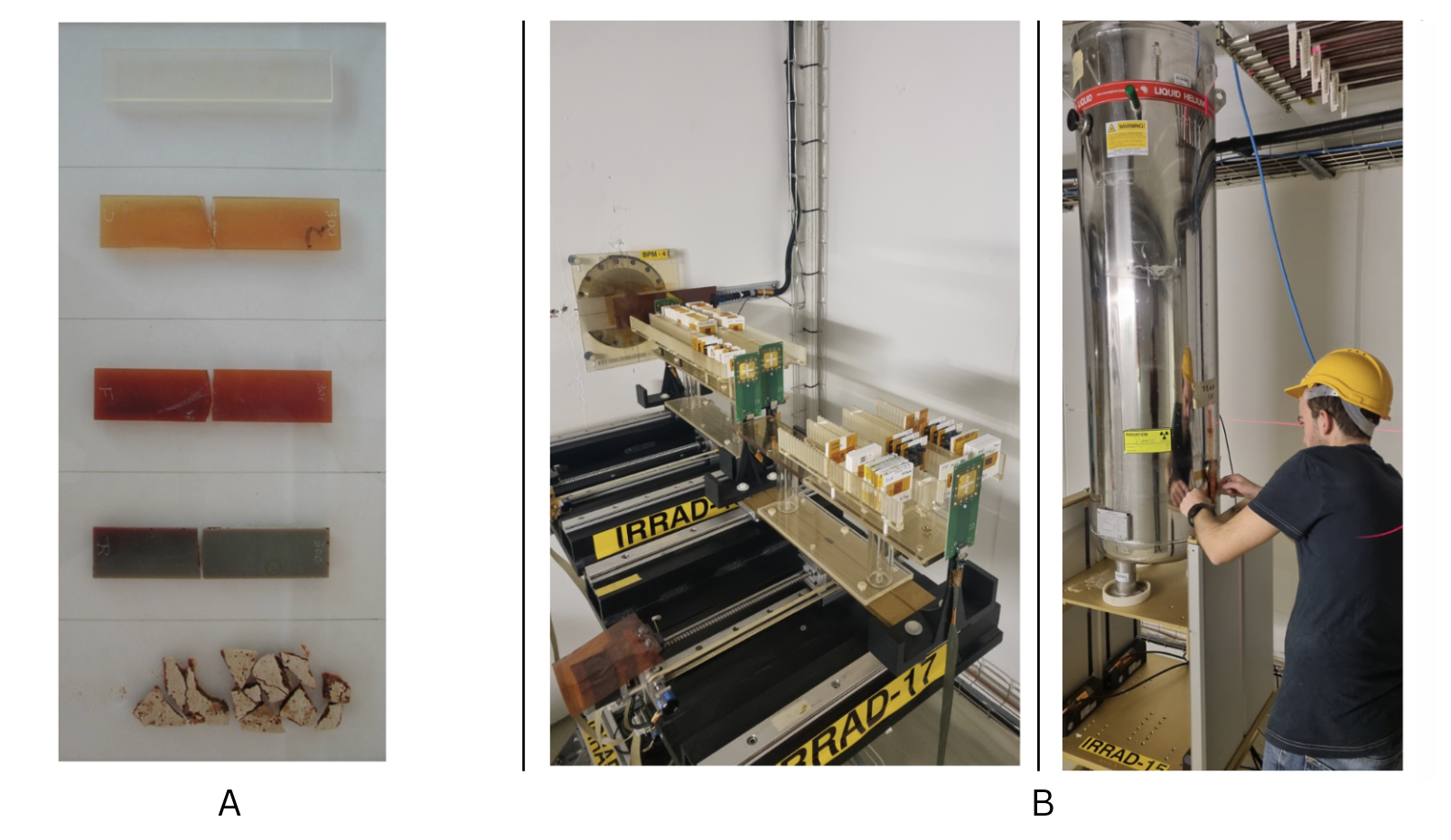
Figure 1: (A) Example radiation effect studies on polymeric materials from the 60’s (courtesy M. Tavlet). (B) Irradiation experiments at the proton IRRAD Facility: material, semiconductor and electronics/detector component passive samples on the irradiation tables (center). Installation of experiments in the LHe cryogenic setup at IRRAD after the LS1 (right-hand side).
Radiation effects on semiconductors were explored during the same period, though not in a systematic way since electronics exposed to radiation was minimal in the LEP machine and experiments. The situation changed in the early 90’s when, for the design and construction of the Large Hadron Collider (LHC), the needs to study new types and test a broader range of materials increased again. The radiation-effect qualification thus shifted mainly towards the detector development groups. In particular, the RD2 detector collaboration began to exploit the T7 proton beam of the CERN PS East Hall for studying the radiation hardness of materials and semiconductors. Because of their potential for high-accuracy particle track location, silicon detectors were an attractive prospect for the upcoming generation of LHC experiments. However, the performance and electrical characteristics of silicon were found to degrade with time during and after irradiation by hadronic particles such as protons and neutrons and, in the LHC experiments, these detectors were expected to withstand particle fluence levels of the order of 1014-1015 cm-2 and MGy doses over their lifetime. Irradiation studies were therefore a pre-requisite before starting the design and the construction of the new particle detectors.
Following the enlargement of this R&D community (first RD48, later RD50) and together with the strong demand from the LHC experiments for testing all kinds of detector components, two irradiation zones were constructed at the end of 1998 in the East Hall experimental area using the 24 GeV/c primary proton beam of the CERN Proton Synchrotron (PS). The proton irradiation facility (IRRAD1, sitting on the T7 beam line) and the neutron facility (IRRAD2, sitting at the end of the T8 beam downstream the DIRAC experiment), were built and operated by the team which is today part of the EP-DT group. In IRRAD2, the irradiations were performed in a very small cavity with a mix-field of secondary particles produced by the primary beam after crossing a target composed of carbon, iron and lead. The primary proton beam in IRRAD1 (mimicking the dominating charged-particle component), and the broad neutron spectrum of IRRAD2 (peaked slightly below 1 MeV) were both well representing the radiation fields expected in the inner and middle detector layers of the LHC experiments. In the period 1999-2012, more than 8100 objects were irradiated at the East Hall going well beyond the original silicon detectors R&D (Fig. 1(B)). Full electronic systems, optical fibers, calorimeter crystals, glues and structural materials are just few examples of the variety of components and material exposed every year [2], [3].
With the launch of the High-Luminosity LHC project (HL-LHC) in 2013, the gears switched again and the focus of the CERN community went on the activities related to the LHC and its Experiments upgrade (Phase II for ATLAS and CMS). This generated an increasing demand for proton irradiations reaching 10-100’s times higher particle fluence levels (1016-1017 cm-2) and doses of some 10’s of MGy. During the same period, within the “Radiation to Electronics” project (R2E) in the A&T sector, the need for testing and validating electronic systems to overcome radiation-related issues and support the upgrades required for equipment in the LHC underground areas also steeply raised. Although, in the meantime, the R2E project built a few ad-hoc parasitic radiation test areas as an intermediate solution [4], these were not ideal for properly evaluating the occurrence of stochastic, single-event effects (SEE) in sensitive electronics systems exposed to mix-field radiation. Both these needs could be satisfied over the longer term only by a dedicated new test facility at the PS East Area that was built during the 2-years Long Shutdown 1 (LS1) [5].
The joint effort of the EP department and the A&T sector (supported by the EU-funded project AIDA) made the upgrade of the East Area Irradiation Facility possible. In IRRAD / CHARM*, operated since October 2014 [6] on the PS T8 beam line by the synergy of the EP-DT and BE-CEM groups, the same protons can be used for both the proton (IRRAD) and mix-field (CHARM) irradiation experiments. While in IRRAD a variety of new irradiation systems are operated as, for instance, to perform irradiations at cryogenic temperatures (Fig. 1(B)), the CHARM mix-particle field generated by a massive target intercepting the beam is now optimized to reproduce the radiation environment of the CERN accelerator complex (LHC tunnel and shielded areas). CHARM can support full system-level tests (Fig. 2(A)), as well as space and atmospheric neutron radiation-effect testing of components and systems. The current IRRAD / CHARM layout is optimized for exploitation as an irradiation facility, with independent access, appropriate shielding, ventilation and sufficient space for the proper installation and easy accessibility of the users and their equipment [7]. In the last 10 years, about 4400 samples and more than 300 system-level tests have been carried out at IRRAD and CHARM, respectively.
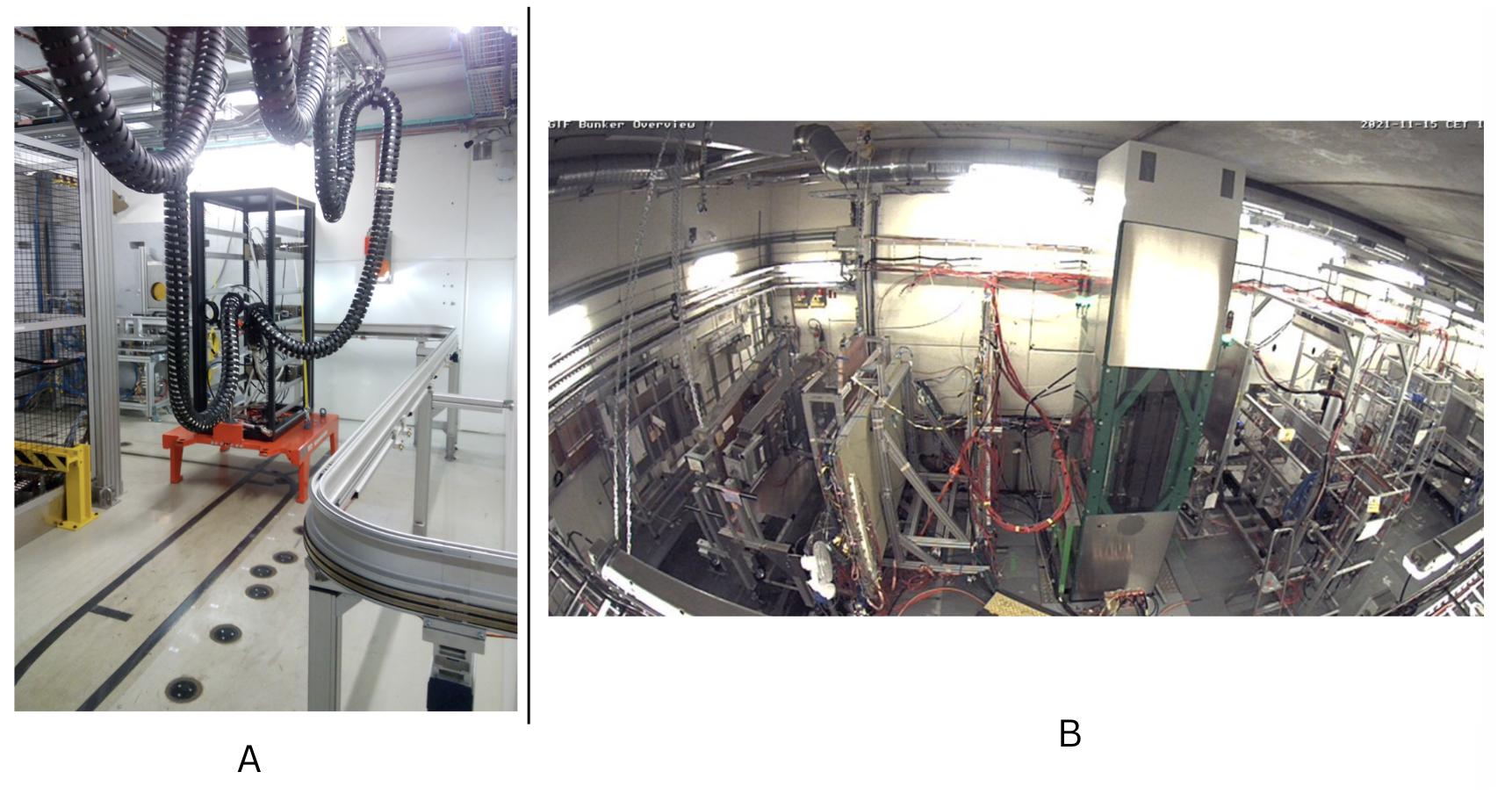
Figure 2: (A) Rack setup for system-level testing positioned inside the CHARM irradiation area. (B) Muon detector setups from various experiments installed in the upstream & downstream fields at the Gamma Irradiation Facility (GIF++).
On average 40 teams from a very heterogeneous user community profit yearly from the services of IRRAD / CHARM, as well as of the access programs offered, for example, by the partner EU-funded projects EURO-LABS or RADNEXT. As in the previous decades, the possibilities offered by the East Area infrastructure, are an invaluable tool for engineers and scientists to improve devices and systems reliability, enable new research or qualify demonstrators of future technologies. There are several examples of this, and we can recall only a few here. The role of IRRAD has proven to be instrumental, for instance, in understanding the FEAST2 DC-DC converter module failure observed in the CMS pixel system in 2018 [8]. CHARM, through the bilateral cooperation agreement with ESA, is instead enabling users from the aerospace community to perform batch screening of electronics components or boards and testing large systems such as medium-sized satellites in full operating conditions [9]. More recently in 2024, the EU-funded HEARTS** project also marked a significant milestone in its efforts to boost Europe’s capabilities in testing space electronics by successfully completing its first user pilot campaign with very high-energy lead beams nowadays also driven to IRRAD in alternative to protons when available in the CERN accelerator complex. (Fig. 3(A)) [10].
As mentioned earlier, in the context of CERN’s 70th anniversary and the diverse activities related to irradiation tests and facilities, another example of a successful joint venture between the EP department and the A&T sector is the renewed Gamma Irradiation Facility (GIF++). Located on the H4 beamline in the SPS North Area (EHN1) GIF++, operated since 2015 by the EP-DT group, was specifically designed to support the ongoing mass-production and ageing tests for muon detectors of the LHC Phase II upgrade, with the unique combination of a strong gamma source (137Cs) and a high-energy muon beam [11] (Fig. 2(B)). Equipped with a comprehensive gas distribution system and a wide range of available gases, the facility regularly hosts yearly about 20 large-scale muon detectors from all four LHC experiments as well as from outside or newly formed collaborations. An example of the fundamental impact that GIF++ has in detector R&D beyond the boundaries of HEP is the support given to the ECOgas@GIF++ collaboration [12] in exploring new environmentally friendly alternative gas mixtures for gaseous detectors technologies and thus aiming to reduce the Global Warming Potential (GWP) index of the currently employed gas mixtures from thousands down to a few units, as prescribed by the current EU regulations.
The radiation-test activities and examples detailed above within the PS East and SPS North Areas address a significant portion of the current needs of CERN’s rapidly evolving community, but they cannot fulfil them all. As the ongoing update of the European Strategy for Particle Physics sets future priorities for colliders and experiments—along with the subsequent need for new facilities or facility upgrades to support their development—the importance of CERN’s existing irradiation facilities [13] and recently established test areas, such as for instance the one at n_TOF-NEAR [14], must also be acknowledged. Pursuing radiation-to-material qualifications, beam instrumentation developments, supporting the newly formed detector DRDs collaborations, or fostering new projects requiring specific irradiation means (as at the CERN Linear Electron Accelerator for Research – CLEAR, Fig. 3(B)), etc. pushes the community to exploit, when possible, the flexibility of the CERN accelerator complex as well as, following the example from the 60’s, to continue profiting of the offer of external facilities (see CERN Database, Fig. 4(B)) belonging to the industry or other scientific communities.

Figure 3: (A) user from external company adjusting his electronics circuit in the HEARTS@CERN radiation testing set up during the lead ion (Pb) user pilot campaign at the IRRAD facility in 2024. (B) Experimental setup at CLEAR used to study the radiation field generated by 200-MeV Electrons on a Target for possible future exploitation in radiation-to-electronics testing (from [15]).
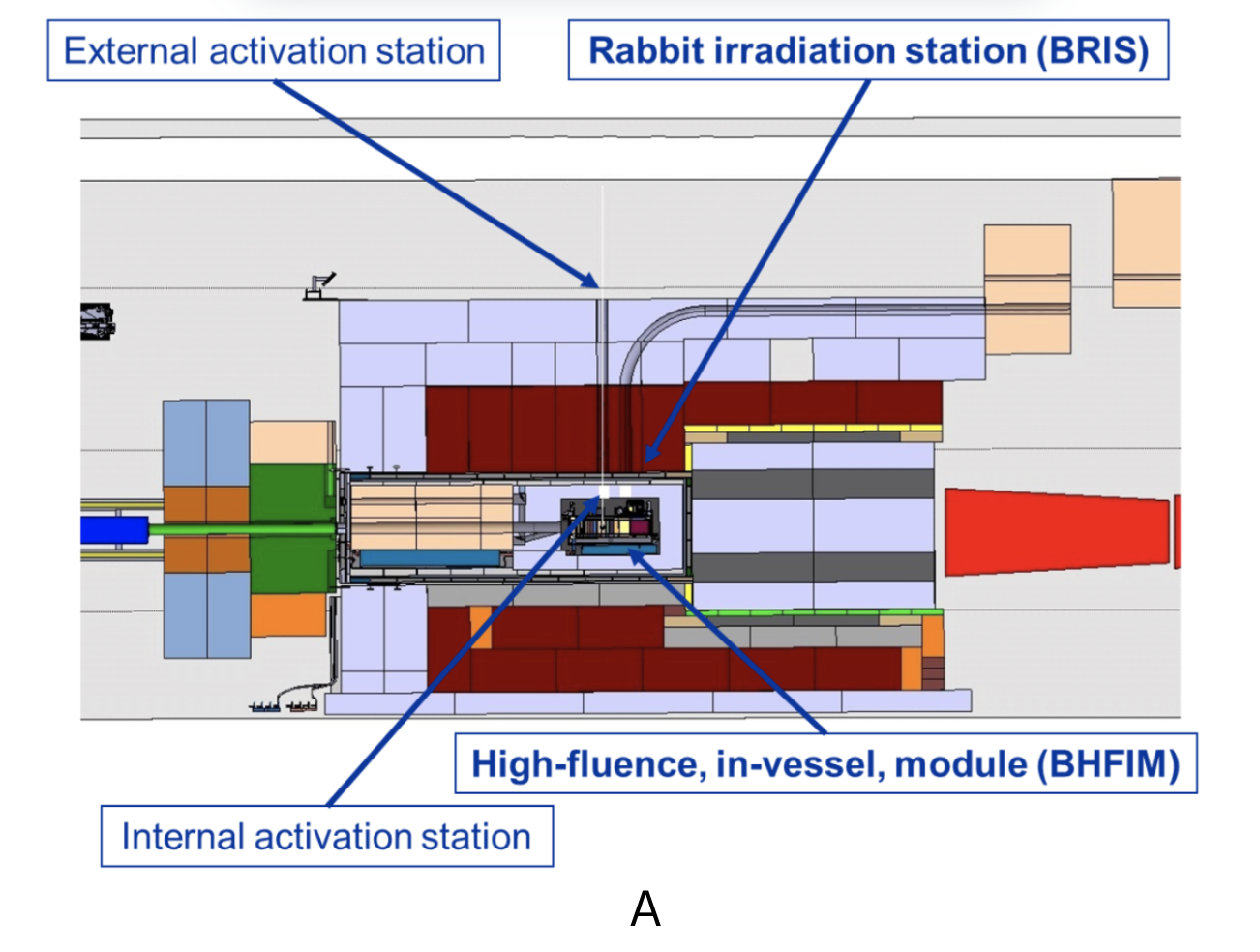
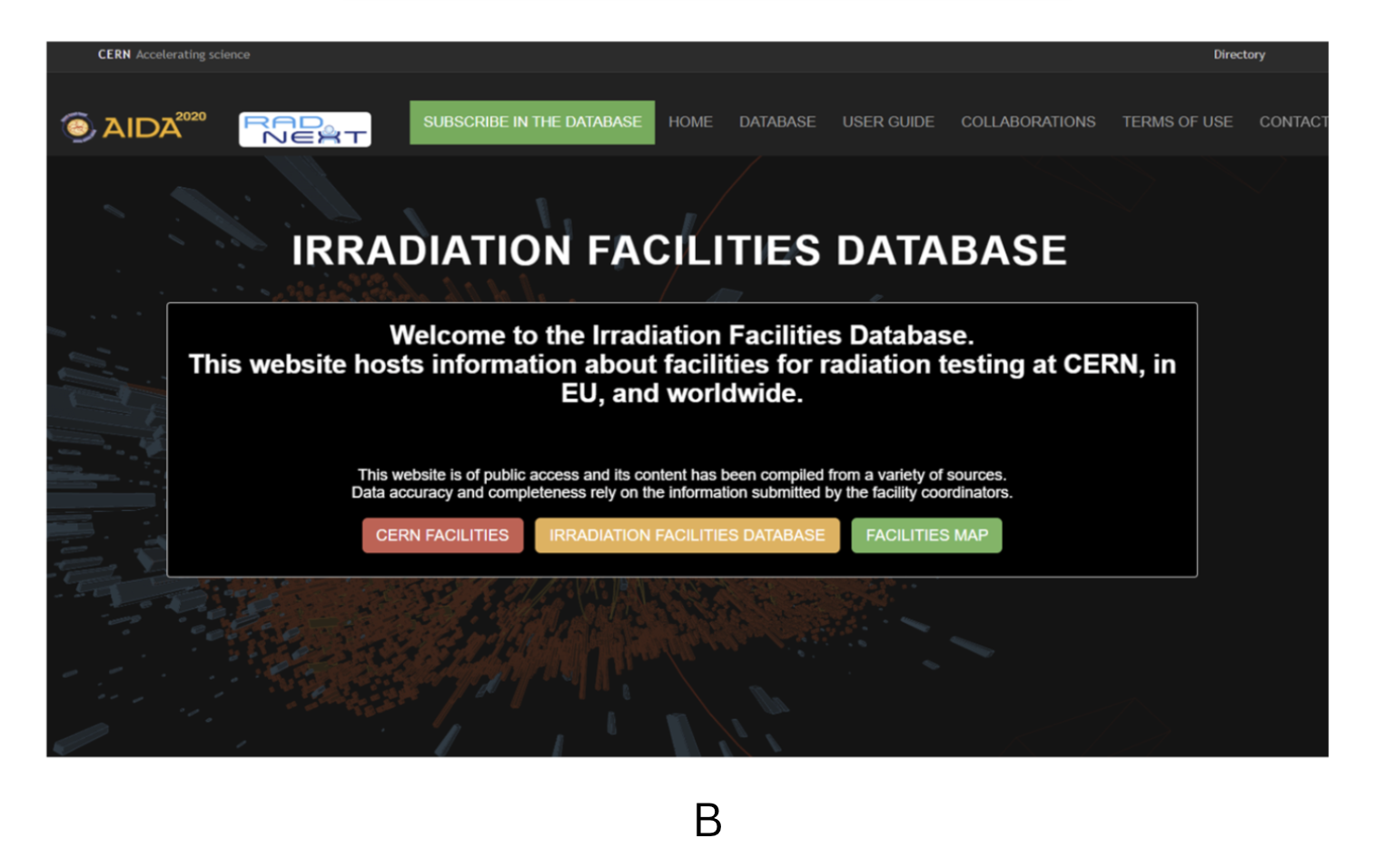
Figure 4: (A) Irradiation opportunities for neutron irradiation around the HI-ECN3 target station evaluated during the workshop in 2024. (B) CERN Irradiation Facilities Database web-portal.
The ambitious future HEP experimental programme currently envisaged at the horizon 2040-2045 and beyond (FCC, Muon Collider, etc.) will, once more, challenge the capability of our testing infrastructure to make available suitable radiation fields for experiments and R&D. This is about the foreseen unprecedent radiation levels (particle fluences in the 1018 cm-2 ballpark and doses exceeding several 100’s MGy) but also about particle types and energy spectra, since lepton and/or hadron-based experimental facilities have heterogeneous radiation testing needs. Therefore, preparing for the next steps to come, a CERN-wide Strategy Panel on Radiation to Materials and Electronics (the RME-SP) has been mandated in 2024 to ensure a coordinated and coherent approach at CERN to the study of radiation effects on materials, electronics, and sensors, including their testing and qualification. Among its tasks, the RME-SP maintains a roadmap for future irradiation requirements, assessing the need to adapt the in-house radiation facilities and the opportunities for the development or use of new Irradiation Facilities both internally and/or outside CERN. An example of this work-in-progress is the evaluation of the possibilities for neutron irradiations offered by the upcoming target station at the recently approved HI-ECN3 experimental facility that was carried out by the RME-SP during a dedicated Workshop at CERN [16] in November 2024 (Fig. 4(A)).
Notes
*CHARM stands for CERN High-energy AcceleRator Mixed field
**HEARTS stands for High-Energy Accelerators for Radiation Testing and Shielding
Further Reading
-
M. Tavlet, et al, Radiation damage studies on materials at CERN, EIRO Workshop Rad. Hard. – Lisbon, Portugal, 16-18 March 2010.
-
F. Ravotti, M. Glaser and M. Moll, "Dosimetry Assessments in the Irradiation Facilities at the CERN-PS Accelerator," IEEE Trans. Nucl. Sci., vol. 53, no. 4, pp. 2016-2022, 2006.
-
F. Ravotti, M. Glaser, “The new proton & mixed-field Irradiation facility at CERN PS”, EP Newsletter Archive, 2013.
-
R. Kwee et al., “Commissioning and Operation of the H4IRRAD Mixed-Field Test Area”, CERN-ATS-Note-2011-121 PERF, 2011.
-
F. Ravotti, “CERN Irradiation Facilities”, Joint DT-ESE Training Seminar, INDICO 303726, 24 June 2014.
-
F. Ravotti, M. Glaser, “First beams for the new East Area Irradiation Facility”, EP Newsletter Archive, 2014.
-
P. Pelissou, et al., "IRRAD/CHARM, a CERN Irradiation Facility for Accelerator & Experiments Radiation Hardness Qualification" In Proc. of 2024 IEEE REDW in conjunction with 2024 NSREC, Ottawa, ON, Canada, 2024, pp. 1-6, https://doi.org/10.1109/REDW61286.2024.10759157.
-
F. Faccio, “ASIC survival in the radiation environment of the LHC experiments: 30 years of struggle and still tantalizing”, Nucl. Inst. And Meth. A vol. 1045, paper 167569, 1 January 2023.
-
D. Pfeiffer et al., “The Radiation Field in the New Gamma Irradiation Facility (GIF++) at CERN”, Nucl. Inst. and Meth. A 866, pp. 91-103, 2017, https://doi.org/10.1016/j.nima.2017.05.045.
-
The RPC ECOgas@GIF++ collaboration, “Exploring eco-friendly gas mixtures for resistive plate chambers: A comprehensive study on performance and aging”, Nucl. Inst. and Meth. A 1068, paper 169747, 2024.
-
B. Gkotse et al., "Irradiation Facilities at CERN", Proc. 17th Eur. Conf. on Rad. and its Effects on Comp. & Systems (RADECS), Geneva, Switzerland, pp. 1-7, https://doi.org/10.1109/RADECS.2017.8696163, 2017.
-
M. Ferrari et al., “Design development and implementation of an irradiation station at the neutron time-of-flight facility at CERN”, Phys. Rev. Accel. Beams, vol. 25(10), 19 pages, paper 103001, 2022.
-
G. Lerner et al., "Analysis of the Radiation Field Generated by 200-MeV Electrons on a Target at the CLEAR Accelerator at CERN," in IEEE Trans. on Nucl. Sci., vol. 70, no. 8, pp. 1572-1579, Aug. 2023, http://doi.org/10.1109/TNS.2023.3252808.
-
HI-ECN3 Irradiation Opportunities Workshop, 6 Nov. 2024, https://indico.cern.ch/event/1468767/.
